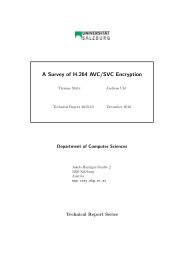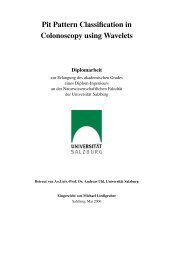Single-sensor hand and footprint-based multimodal biometric ...
Single-sensor hand and footprint-based multimodal biometric ...
Single-sensor hand and footprint-based multimodal biometric ...
Create successful ePaper yourself
Turn your PDF publications into a flip-book with our unique Google optimized e-Paper software.
4 Preprocessing<br />
4.2.1 Fast Otsu Thresholding<br />
Let pi refer to the probability of grey level i within the image B <strong>and</strong> let µ be the mean<br />
intensity of the image. Otsu’s Method [29] is a global thresholding algorithm, i.e. a global<br />
threshold t ∈ {0, . . . l + 1} is selected, such that the new binary image B ′ is given by:<br />
B ′ (x, y) =<br />
�<br />
1 if B(x, y) ≥ t,<br />
0 otherwise.<br />
. (4.1)<br />
Since light reflected by the sole of the foot or palm is converted into pixels with higher<br />
intensities, this leads to a good separation of background (represented by the class C1<br />
with grey levels {0, . . . , t − 1}) <strong>and</strong> sole/palm (represented by the class C2 with grey levels<br />
{t, . . . , l}). For a given threshold t <strong>and</strong> class k ∈ {1, 2}, let ωk refer to the class probability<br />
<strong>and</strong> µk refer to the mean for Ck [20]:<br />
ωk := �<br />
pi; (4.2)<br />
i∈Ck<br />
µk := 1 �<br />
i pi. (4.3)<br />
ωk i∈Ck<br />
Otsu’s method chooses t ∗ , such that the between-class variance σ 2 B is maximised [20]:<br />
σ 2 2�<br />
B(t) := ωk(µk − µ)<br />
k=1<br />
2 2�<br />
= ωkµk<br />
k=1<br />
2 − µ 2 ; (4.4)<br />
t ∗ = arg max{σ<br />
1≤t≤l<br />
2 B(t)}. (4.5)<br />
Since obtaining ωk <strong>and</strong> µk for each threshold t involve many recurring operations, an<br />
improved fast threshold search can be implemented using lookup-tables of recursively<br />
calculated zeroth- <strong>and</strong> first-order moments of pixel intensities u to v, as illustrated in<br />
[20].<br />
4.2.2 Canny-edge-detection <strong>based</strong> binarisation<br />
In order to preserve foot edges for accurate shape feature extraction within the <strong>footprint</strong><br />
system, first Canny edge detection [2] with binary thresholding on the original image B<br />
is employed. This step keeps the most significant edges only which reliably represent foot<br />
contours. Then, within the obtained edge image B1, the interior of the foot is filled using<br />
binary thresholding on B, i.e.<br />
36<br />
B2(x, y) := max(B ′ (x, y), B1(x, y)); (4.6)








